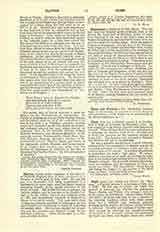

Cleef, JAN VAN, a Flemish painter, b. in Guelderland in 1646; d. at Ghent, December 18, 1716. He was a pupil of Luigi Primo (Gentile) and Gaspard de Craeyer. When Craeyer died, Cleef was commissioned to complete his master’s work in the churches and to finish the cartoons for the tapestry ordered by Louis XIV. The churches and convents in Flanders and Brabant are rich in his paintings.
He was a splendid draughtsman, a good colorist, celebrated for his management of drapery and for his charming portrayal of children’s heads and the attractive faces of his women. In a school pre-eminent in portraiture Jan held a high place. He accomplished a vast amount of work, all showing the influence of his masters and tending more to Italian than Flemish methods. His favorite subjects were Scriptural and religious, and his treatment of them was simple and broad. His masterpiece, “Nuns Giving Aid during the Plague”, in the convent of the Black Nuns, at Ghent, rivals the work of Van Dyck.
LEIGH HUNT.

